Lion: Difference between revisions
Autocratique (talk | contribs) m Reverted 1 edit by 209.66.200.6 to last revision by SparrowsWing. (TW) |
Rick marin (talk | contribs) →Social behavior: links added |
||
| Line 48: | Line 48: | ||
==Social behavior== |
==Social behavior== |
||
[[Image:Lions lying.jpg|thumb|left|Male lions spend most of their life resting.]] |
[[Image:Lions lying.jpg|thumb|left|Male lions spend most of their life resting.]] |
||
[[Image:Pride_of_lions.JPG|thumb|right|Pride of lions on the move, |
[[Image:Pride_of_lions.JPG|thumb|right|Pride of lions on the move, [[Masai Mara]], [[Kenya]]]] |
||
Lions are predatory [[carnivore]]s who manifest two types of social organization. Some are ''residents,'' living in groups, called ''prides''. The pride consists of related females, their cubs of both sexes, and a group of one to four males known as a ''coalition'' who mate with the adult females. Others are ''nomads'', ranging widely, either singly or in pairs. |
Lions are predatory [[carnivore]]s who manifest two types of social organization. Some are ''residents,'' living in groups, called ''prides''. The pride consists of related females, their cubs of both sexes, and a group of one to four males known as a ''coalition'' who mate with the adult females. Others are ''nomads'', ranging widely, either singly or in pairs. |
||
Revision as of 21:29, 28 February 2007
| Lion | |
|---|---|

| |
| Scientific classification | |
| Kingdom: | |
| Phylum: | |
| Class: | |
| Order: | |
| Family: | |
| Genus: | |
| Species: | P. leo
|
| Binomial name | |
| Panthera leo | |

| |
| Distribution of Lions in Africa | |
| Synonyms | |
|
(Linnaeus, 1758) | |
The lion (Panthera leo) is a mammal of the family Felidae and one of four "big cats" in the genus Panthera. The lion is the second largest feline species, after the tiger. The male lion, easily recognized by his mane, weighs between 150–300 kg (330–550 lb). Females range 120–150 kg (260–330 lb).[2] In the wild, lions live for around 10–14 years, while in captivity they can live over 20 years. Though they were once found throughout much of Africa, Asia and Europe, lions presently exist in the wild only in Africa and India.
Population and distribution
In historic times the habitat of lions spanned the southern parts of Eurasia, ranging from Portugal to India, and most of Africa except the central rainforest-zone and the Sahara desert. Around the beginning of the current era, they died out from Western Europe, and they had become extinct in Greece by AD 100. In the Caucasus, their last European outpost, lions were found until the 10th century. Between the late 19th and early 20th century they also became extinct from North Africa and the Middle East. Now, most of the population lives in eastern and southern Africa, and their numbers are rapidly decreasing, estimated as between 16,000 and 30,000 living in the wild, down from an estimated 100,000 in the early 1990s. The population is even more in jeopardy because the remaining populations are often geographically isolated from each other, which causes inbreeding.
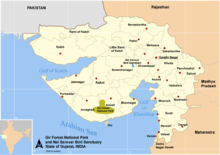
The Asiatic Lion (Panthera leo persica), which in historical times ranged from Turkey to India through Iran (Persia) and from the Caucasus to Yemen, was eradicated from Palestine by the Middle Ages and from most of the rest of Asia after the arrival of readily available firearms in the 18th century. In Iran the last lion was shot in 1942. The subspecies now survives only in and around the Gir Forest of northwestern India. About 300 lions live in a 1412 km² (558 square miles) sanctuary in the state of Gujarat, which covers most of the forest. Their numbers remain stable.
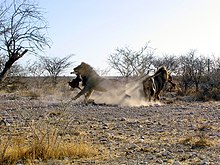
Until the late Pleistocene, lions were also found in the Americas and in northern Eurasia. The most famous of these prehistoric subspecies were the Cave Lion (Panthera leo spelaea) and the American Lion (Panthera leo atrox) (not to be confused with the Cougar, which is also known as the Mountain Lion).
Diet and hunting

Female lions usually hunt at night or dawn and in packs. Their prey consists mainly of large mammals, such as antelopes, gazelles, warthogs, wildebeest, buffalos and zebras, but smaller animals like hares and birds are also taken occasionally. Carrion is readily taken and often recovered from other predators like hyenas and wild dogs. In some areas, lions specialise on rather atypical prey-species; this is the case at the Savuti river, where they constantly prey on young elephants, and at the Linyanti, where they hunt hippos (both rivers are in Chobe National Park, Botswana). It is reported that the lions, driven by extreme hunger, started taking down baby elephants, then moved on to adolescents and occasionally fully grown adults [1].
Young lions first try hunting at three months old, but are often not successful hunters until they are two years old.

Lions can reach speeds of about 60 km/h (37 mph), but they lack the endurance to be long-distance runners, so they have to come quite close to their prey before starting the attack. They sneak up to the victim until they reach a distance of about 30 m (98 feet) or less. Usually several lions work together and encircle the herd from different points. The attack is short and powerful, and the lion tries to catch the victim with a fast rush and some final leaps. The prey is usually killed by a bite into the nape or throat.
Because lions hunt in open spaces, where they are easily seen by their prey, teamwork increases the likelihood of a successful hunt. Teamwork also enables them to defend their prey more easily against other large predators like hyenas, which can be attracted by vultures over kilometers in open savannas. The males attached to prides do not usually participate in hunting, except in the case of large animals such as buffalo.
An adult female lion needs about 5 kg (11 lbs) of meat per day, a male about 7 kg (15 lbs).
Social behavior

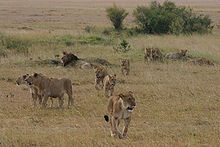
Lions are predatory carnivores who manifest two types of social organization. Some are residents, living in groups, called prides. The pride consists of related females, their cubs of both sexes, and a group of one to four males known as a coalition who mate with the adult females. Others are nomads, ranging widely, either singly or in pairs.
Being smaller and lighter than males, lionesses are more agile and faster and do the pride's hunting, while the stronger males patrol the territory and protect the pride, for which they take the "lion's share" of the females' prey. When resting, lions seem to enjoy good fellowship with lots of touching, head rubbing, licking and purring. But when it comes to food, each lion looks out for itself. Squabbling and fighting are common, with adult males usually eating first, followed by the females and then the cubs.
Both males and females will defend the pride against intruders. Some individual lions consistently lead the defense against intruders, while others lag behind (Heinsohn and Packer 1995). These “laggards” are not punished by leaders. Possibly laggards provide other services to the group so that leaders forgive them (Morrell 1995). An alternative hypothesis is that there is some reward associated with being a leader who fends off intruders (Jahn 1995).
Typically, males will not tolerate outside males, and females will not tolerate outside females. Males are expelled from the pride or leave on their own when they reach maturity.
Lions spend a lot of their time resting. They are inactive for about 20 hours per day.
Reproduction and sexuality

Lions do not mate at any specific time of year, and the females are polyestrous. Like other cats, the male lion's penis has spines which point backwards. Upon withdrawal of the penis, the spines rake the walls of the female's vagina, which may cause ovulation. Furthermore, cats are superfecund; that is, a female may mate with more than one male when she is in heat, meaning different cubs in a litter may have different fathers. During a mating bout, which could last several days, the couple frequently copulate twenty to forty times a day and are likely to forgo hunting. In captivity, lions reproduce very well.
The gestation lasts between one hundred and one hundred twenty days, and the female gives birth to a litter of one to four cubs. The females in a pride will synchronize their reproductive cycles so that they cooperate in the raising and suckling of the young, who suckle indiscriminately from any or all of the nursing females in the pride. Cubs are weaned after six to seven months. In the wild, competition for food is fierce, and as many as 80% of the cubs will die before the age of two.
When a new male (or a coalition) takes over a pride and ousts the previous master(s), the conquerors often kill any remaining cubs. This is explained by the fact that the females would not become fertile and receptive until the cubs grow up or die. The male lions reach maturity at about 3 years of age and are capable of taking over another pride at 4-5 years old. They begin to age (and thus weaken) at around 8. This leaves a short window for their own offspring to be born and mature — the fathers have to procreate as soon as they take over the pride. Sometimes a female may defend her and the ousted male's children from the new master, but such actions are rarely successful, as he usually kills all the previous top male's cubs that are less than two years old.[3]
Observers have reported that both males and females may interact homosexually.[4][5] Male lions pair-bond for a number of days and initiate homosexual activity with affectionate nuzzling and caressing, leading to mounting and thrusting. A study found that about 8% of mountings have been observed to occur be with other males, while female pairings are held to be fairly common in captivity but have not been observed in the wild. In the case of the females, the much older females of ages about 20 would show sexual attraction to younger females and would start a fight with the lioness's mate.
Physical characteristics

The male lion, easily recognized by his mane, can weigh between 150-225 kg (330-500 lb), but usually most males average around 186 kg (410 lb) and females range from 120-150 kg (260-330 lb)[6], and average around 125 kg (275 lb). The largest captive African lion weighed 366 kilograms (806 lb). Head and body length is 170 to 250 cm (5'7" to 8'2") in males and 140 to 175 cm (4'7" to 5'9") in females; shoulder height is about 123 cm (4') in males and 100 cm (3'3") in females. The tail length is 70 to 100 cm (2'3" to 3'3").[7] The tail ends in a hairy tuft. The tuft conceals a spine, approximately 5 mm long, formed of the final sections of tail bone fused together. The lion is the only felid to have tuffed tail and the function of the tuft and spine are unknown.[8] In the wild, lions live for around 10–14 years, while in captivity they can live over 20 years.
The coloration varies from light buff to yellowish, reddish or dark ochraceous brown. The colour of the manes varies from blond to black. The underparts are generally brighter. The tail tuft is black.
Manes

In the past, scientists believed that the "distinct" subspecific status of some subspecies could be justified by their external morphology, like the size of their mane. This morphology was used to identify them, like the Barbary lion and Cape Lion. However, now it is known that various extrinsic factors influence the colour and size of a lion's mane, like the ambient temperature.[9] The cooler ambient temperature in European and North American zoos, for example, can result in a heavy mane. Therefore, the heavy mane is an inappropriate marker for identifying subspecies.[10][11]
Maneless lions have been reported in Senegal and Tsavo-National Park. As well as having an inherited component, the presence, absence and degree of mane is also associated with sexual maturity and testosterone production. Castrated lions have minimal manes. The original male white lion from Timbavati was also maneless. Manelessness is also found in inbred lion populations; inbreeding also results in poor fertility. A heavy mane may provide an indicator of a lion's genetic and physical health. It may also afford him some protection in fights. In some animal species, females show a preference for males with better outward displays of fertility and vigour. It is possible that lionesses more actively solicit mating with heavily maned lions in prides led by a coalition of 2 or 3 males, though there seem to be no published studies.
Evolution
The oldest fossil record of cat, which strongly resembles a lion, is known from Laetoli in Tanzania and is perhaps 3.5 million years old. Some scientists identify the material as Panthera leo. However, these records are not well-substantiated, and all that can be said is that they pertain to a Panthera-like felid. The oldest confirmed records of Panthera leo in Africa are about 2 Ma younger.[12]
700,000 years ago, Panthera leo appeared in Europe for the first time with the subspecies Panthera leo fossilis at Isernia in Italy. From this lion derived the later Cave lion (Panthera leo spelea), which appeared about 300,000 years ago. During the upper Pleistocene the lion spread to North and South America, and developed into Panthera leo atrox, the American lion.[13]
Lions were common in northern Eurasia and America during the upper Pleistocene, but died out there at the end of the last glaciation, about 10,000 years ago.
Taxonomy
Subspecies

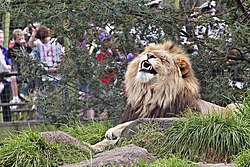
The major differences between lion subspecies are location, mane appearance, size and distribution. However, some of the forms listed below are debatable. Genetic evidence suggests that all modern lions derived from one common ancestor only circa 55,000 years ago. Mitochondrial variation in recent African lions is modest, which suggests that all sub-Saharan lions could be considered a single subspecies, possibly divided in two main-clades – one to the west of the Great Rift Valley and the other to the east. For example, lions from Tsavo (East Kenya) differ genetically hardly from lions in Transvaal (South Africa), but differ considerable from those in the Aberdare Range in Western Kenya.[14] [15]
Most scientists today recognise subspecies (not all named here are considered valid by all scientists).[16]
- Panthera leo azandica - North East Congo lion.
- Panthera leo bleyenberghi - Katanga lion or Southwest African lion. Zimbabwe, Angola, Katanga (Zaire).
- Panthera leo europaea - European lion. Status as subspecies is unconfirmed. (Probably identical with Panthera leo persica or Panthera leo spelea) Extinct around 100 A.D. due to persecution and over-exploitation. Inhabited the Balkans, the Italian Peninsula, southern France and the Iberian Peninsula. It was a very popular object of hunting among Romans, Greeks and Ancient Macedonians.
- Panthera leo hollisteri - Congo lion.
- Panthera leo krugeri - South African lion or Southeast African lion. Transvaal.
- Panthera leo leo (P. l. berberisca) - Barbary lion; extinct at least in the wild and was believed to be extinct in captivity. This was the largest of the lion subspecies, which ranged from Morocco to Egypt. The last wild Barbary lion was killed in Morocco in 1922 due to excessive hunting. Barbary lions were kept by Roman emperors to take part in the gladiator arenas. Roman notables, including Sulla, Pompey, and Julius Caesar, often ordered the mass slaughter of Barbary lions - up to 400 at a time [2].
- Panthera leo maculatus - Marozi.[17] Status as subspecies is unconfirmed. Distinguishable from other subspecies by its spotted coat. Thought to be extinct since 1931. May have been a natural leopard/lion hybrid.
- Panthera leo massaicus - Massai Lion.
- Panthera leo melanochaita - Cape Lion; extinct in 1860.
- Panthera leo nubica - East African Lion.
- Panthera leo persica - Asiatic Lion or South Asian lion. 350 currently exist in and near the Gir Forest of India. Once widespread from Turkey, across the Middle East, to Pakistan, India and even Bangladesh, but large prides and daylight activity made it easier to poach than tigers or leopards.
- Panthera leo roosevelti - Abyssinian lion.
- Panthera leo somaliensis - Somali lion.
- Panthera leo senegalensis - West African lion, or Senegal lion. Western Africa.
- Panthera leo verneyi - Kalahari lion. Distinct behaviour and anatomy has been observed in this subspecies.
Besides these subspecies there are also some prehistoric ones. [18]
- Panthera leo atrox - American Lion or North American cave lion, about 35,000 to 10,000 years ago.
- Panthera leo fossilis - Early Middle Pleistocene European cave lion, about 500,000 years ago.
- Panthera leo sinhaleyus - Sri Lanka lion or Ceylon lion.
- Panthera leo spelaea - European cave lion, Eurasian cave lion or Upper Pleistocene European cave lion (300,000 to 10,000 years ago).[19]
- Panthera leo toscana - Tuscany lion - European primitive cave lion, was present around 1.6 million years ago.
- Panthera leo vereshchagini - East Siberian or Beringian cave lion
- Panthera leo youngi - North-Eastern Pleistocene China cave lion, 350,000 years ago.
meow
Variations
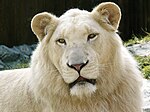
A number of natural variations have been observed in the lion populations. Some of these have been encouraged by captive breeding.
White lions
Although rare, white lions are occasionally encountered in Timbavati, South Africa. Their unusual color is due to a recessive gene. A white lion has a disadvantage when it comes to hunting: it can be given away by its color, unlike the regular lion which blends in with its surroundings. White lions are born almost pure white without the normal camouflaging spots seen in lion cubs. Their colour gradually darkens to cream or ivory colour (known as blonde).
Cross-breeding lions with other big cat species
Lions have also been known to breed with tigers (most often Amur and Bengal) to create hybrids called ligers and tigons. They have also been crossed with leopards to produce leopons and jaguars to produce jaglions. The marozi is reputedly a spotted lion or a naturally occurring leopon, while the Congolese spotted lion is a complex lion/jaguar/leopard hybrid called a lijagulep. Such hybrids were once commonly bred in zoos, but this is now discouraged due to the emphasis on conserving species and subspecies. Hybrids are still bred in private menageries and in zoos in China.
The liger is a cross between a male lion and a tigress. Because the lion sire passes on a growth-promoting gene, but the corresponding growth-inhibiting gene from the female lion is absent, ligers grow far larger than either parent. They share physical and behavioural qualities of both parent species (spots and stripes on a sandy background). Male ligers are sterile, but female ligers are often fertile. Males have about a 50% chance of having a mane, but if they grow one the mane will be modest, around 50% again of a pure lion mane.
The less common tigon is a cross between the lioness and the male tiger. Because the male tiger does not pass on a growth-promoting gene and the lioness passes on a growth inhibiting gene, tigons are often relatively small, only weighing up to 150 kilograms (350 lb), which is about 20% smaller than lions. Like ligers, they have physical and behavioural traits from both parental species and males are sterile.
Attacks on humans
This article needs additional citations for verification. |
While lions usually don't attack humans, some (usually male) lions seem to seek out human prey. Some of the more publicized cases include the Tsavo maneaters and the Mfuwe man-eater. In both cases the hunters who killed the lions wrote books detailing the lions' "careers" as man-eaters. In folklore, man-eating lions are sometimes considered demons.
The Mfuwe and Tsavo incidents did bear some similarities. The lions in both the incidents were all larger than normal, lacked manes and seemed to suffer from tooth decay. Some have speculated that they might belong to an unclassified species of lion, or that they may have been sick and could not have easily caught prey.
There have also been recorded attacks on humans by lions in captivity; tigers in captivity are statistically much more likely to attack humans. Wild lions are also much less likely to attack humans than wild tigers are.
Other contemporary research shows that lion-human conflict may be on the rise. Thomas P. Gnoske and Julian C. K. Peterhans suggest that we should be surprised not that lions attack and kill humans but that such few incidents occur. The stereotype of injury and age being the main causes of man-eating behavior are largely debunked by the two men. [3]
Also, Professor Craig Packer of the University of Minnesota and Tanzanian scientist Dennis Ikanda authored an important paper in Nature in 2006 that showed man-eating behavior in rural areas of Tanzania had increased greatly from 1990 through 2005. More than 500 villagers were attacked and many eaten in this time period - a number far exceeding the more famed "Tsavo" incidents of a century and more earlier. The problem occurred near Selous National Park in Rufiji District and in Lindi Province near the Mozambican border. While some of these problems are no doubt caused by the expansion of villagers into bush country, the authors argue that conservation policy must mitigate the problem because conservation policies contribute directly to human deaths. Cases in Lindi have been documented where lions seize humans from the center of substantial villages.
Author Robert R. Frump also wrote in a book, The Man-eaters of Eden, published in 2006, that Mozambican refugees crossing Kruger National Park at night in South Africa regularly are attacked and eaten by the lions there. Park officials conceded that man-eating is a problem there. Frump believes thousands may have been killed in the decades after apartheid sealed the park and forced the refugees to cross the park at night. Mozambicans had for nearly a century before the border was sealed regularly walked across the park in daytime with little harm. [20]
Generally, westerners do not understand the toll that animal-human conflict takes on human lives and crops in Africa. Packer estimates more than 200 Tanzanians are killed each year by lions, crocodiles, elephants, hippos and snakes, and that the numbers could be double that amount. Lions are thought to kill about 70 humans per year at least in Tanzania, Packer and Ikanda note. Packer and Ikanda are among the few conservationists who believe western conservation efforts must take account of these matters not just because of ethical concerns about human life, but also for the long term success of conservation efforts and lion preservation.
A man-eating lion was killed by game scouts in Southern Tanzania in April 2004. It is believe to have killed and eaten at least 35 people in a series of incidents covering several villages in the Rufiji Delta coastal region.[4] [5] Dr Rolf D. Baldus, the GTZ wildlife programme coordinator, is reported to have commented that it was likely that the lion preyed on humans because it had a large abscess underneath a molar which was cracked in several places. He further commented that "This lion probably experienced a lot of pain, particularly when it was chewing." [6] GTZ is the German development cooperation agency and has been working with the Tanzanian government on wildlife conservation for nearly two decades. Like in other cases this lion was large, lacked a mane, and had a tooth problem.
The "All-Africa" record of man-eating generally is considered to be not Tsavo, but the lesser known incidents in the late 1930s through the late 1940s in what was then Tanganyika (now Tanzania). George Rushby, game warden and professional hunter, eventually dispatched the pride, which over 3 generations, is thought to have killed and eaten 1,500 to 2,000 in what is now Njombe district.
Tsavo and Patterson body counts vary from a pretty firm 28 up to 140. While some authors disparage the actual number, it should be kept in mind that Patterson kept firm records of skilled-labor killed by the lions, not indigenous Africans. The toll could easily have been much higher.
Lions in popular culture
Lions appear as a theme in cultures across Europe, Asia and Africa. Despite the recorded incidents of attacks on humans, lions enjoy positive depiction in pop culture as creatures that appear strong but gentle at the same time. The most consistent depiction is in keeping with their image of "King of the jungle", hence the lion being a popular symbol of royalty and stateliness.
See also
- Asiatic Lion
- Barbary Lion Extinct in the wild. It is the asiatic lion's nearest cousin.
- European lion
- Cape Lion
- Lion-baiting
- Lion taming
- Liger
- Marsupial lion
- In-situ conservation
- Ex-situ conservation
- Wildlife conservation
- Extinction
References
- ^ Template:IUCN2006 Database entry includes a lengthy justification of why this species is vulnerable
- ^ "BBC - Science & Nature - Wildfacts - Lion". Retrieved 2006-10-24.
- ^ Honolulu Zoo lion information page
- ^ Bruce Bagemihl, Biological Exuberance: Animal Homosexuality and Natural Diversity, St. Martin's Press, 1999; pp.302-305. In his discussion of lion same-sex relations, Bagemihl is making use of published work by: J.B. Cooper, "An Exploratory Study on African Lions" in Comparative Psychology Monographs 17:1-48; R.L. Eaton, "The Biology and Social Behavior of Reproduction in the Lion" in Eaton, ed. The World's Cats, vol.II; pp.3-58; Seattle, 1974; G.B. Schaller, The Serengeti Lion; University of Chicago Press, 1972
- ^ Suvira Srivastav, Lion, Without Lioness in TerraGreen website
- ^ "BBC Wildfacts – Lion".
- ^ Ronald M. Nowak: Walker's Mammals of the World. Johns Hopkins University Press, 1999 ISBN 0-8018-5789-9
- ^ "The Cyber Zoomobile - lion".
- ^ West P.M., Packer C. 2002. Sexual selection, temperature, and the lion's mane. Science, 297, 1339–1343.
- ^ Barnett, R., N. Yamaguchi, I. Barnes & A. Cooper. 2006. Lost populations and preserving genetic diversity in the lion Panthera leo: Implications for its ex situ conservation. Conservation Genetics. Online full-text pdf
- ^ Yamaguchi, N. & Haddane, B. (2002). The North African Barbary lion and the Atlas Lion Project. International Zoo News 49: 465-481.
- ^ Lars Werdelin: Plio-Pleistocene Carnivora of eastern Africa: species richness and turnover patterns, Zoological Journal of the Linnean Society, Volume 144, Issue 2, Page 121 - June 2005 online
- ^ A. Turner: The big cats and their fossil relatives. Columbia University Press, 1997. ISBN 0-231-10229-1
- ^ Ross Barnett et al.: The origin, current diversity and future conservation of the modern lion (Panthera leo). Proceedings of the Royal Society B, doi: 10.1098/rspb. (2006) Published online (PDF)
- ^ Jean Dubach et al.: Molecular genetic variation across the southern and eastern geographic ranges of the African lion, Panthera leo. Conservation Genetics 6: 15–24, 2005. online-PDF.
- ^ Barnett, R., N. Yamaguchi, I. Barnes & A. Cooper. 2006. Lost populations and preserving genetic diversity in the lion Panthera leo: Implications for its ex situ conservation. Conservation Genetics. Online pdf
- ^ The Marozi, a spotted lion, is sometimes believed to be a distinct subspecies (Panthera leo maculatus), but may be an adult lion that has retained its juvenile spotted pattern. If it was a subspecies in its own right, rather than a small number of aberrantly colored individuals, it has been extinct since 1931. A less likely identity is a natural leopard/lion hybrid commonly known as a leopon.
- ^ Burger J, Rosendahl W, Loreille O, Hemmer H, Eriksson T, Götherström A, Hiller J, Collins MJ, Wess T, Alt KW. (2004). Molecular phylogeny of the extinct cave lion Panthera leo spelaea. Mol. Phylogenet. Evol., 30, 841–849. Online pdf
- ^ Burger J, Rosendahl W, Loreille O, Hemmer H, Eriksson T, Götherström A, Hiller J, Collins MJ, Wess T, Alt KW. (2004). Molecular phylogeny of the extinct cave lion Panthera leo spelaea. Mol. Phylogenet. Evol., 30, 841–849. Online pdf
- ^ Frump, R. (2006) The Man-eaters of Eden, The Lyons Press. ISBN 1-592288-92-9
- Heinsohn, R. and Packer, C. 1995. Complex cooperative strategies in group-territorial African lions. Science 269: 1260-1262.
- Jahn, G. C. 1996. "Lioness Leadership," Letters. Science 271: 1215.
- Morell, V. 1995. Cowardly lions confound cooperation theory. Science 269: 1216-1217.
External links
- Rare behaviour - swimming lions
- The Kingdom of Lions
- Asiatic Lion Information Centre
- Asiatic Lion and Gir Protection Soc.
- Lion: Wildlife summary from the African Wildlife Foundation
- ARKive - images and movies of the lion (Panthera leo)
- Lion (Panthera leo) from “ARKive images of life on Earth” website
- Panthera leo (lion) from “Animal Diversity Web”
- White Lions
- Heraldic dictionary. Positions of Beasts as Exemplified by Lions
- Lions in Jewish art
- Lion Research Center - the official website of a research group at the U. of Minnesota that has conducted extensive field research on lions and has published over 50 peer-reviewed scientific articles on lions.
- Owner of the heaviest living lion in captivity in the world
- Lion Conservation Fund - A fund dedicated to the research and conservation of the lion
- Nature Documentary: "The Vanishing Lions"
- SuperLions of africa
- Pictures of the African lion
- Pictures of the Asian lion
- Vulnerable species
- Lions
- Mammals of Africa
- Fauna of West Africa
- Fauna of East Africa
- Fauna of the Sahara
- Fauna of Ethiopia
- Mammals of India
- Fauna of Namibia
- Fauna of Angola
- Fauna of Botswana
- Fauna of South Africa
- Fauna of the Democratic Republic of the Congo
- Fauna of Zambia
- Fauna of Kenya
- National symbols of the United Kingdom
